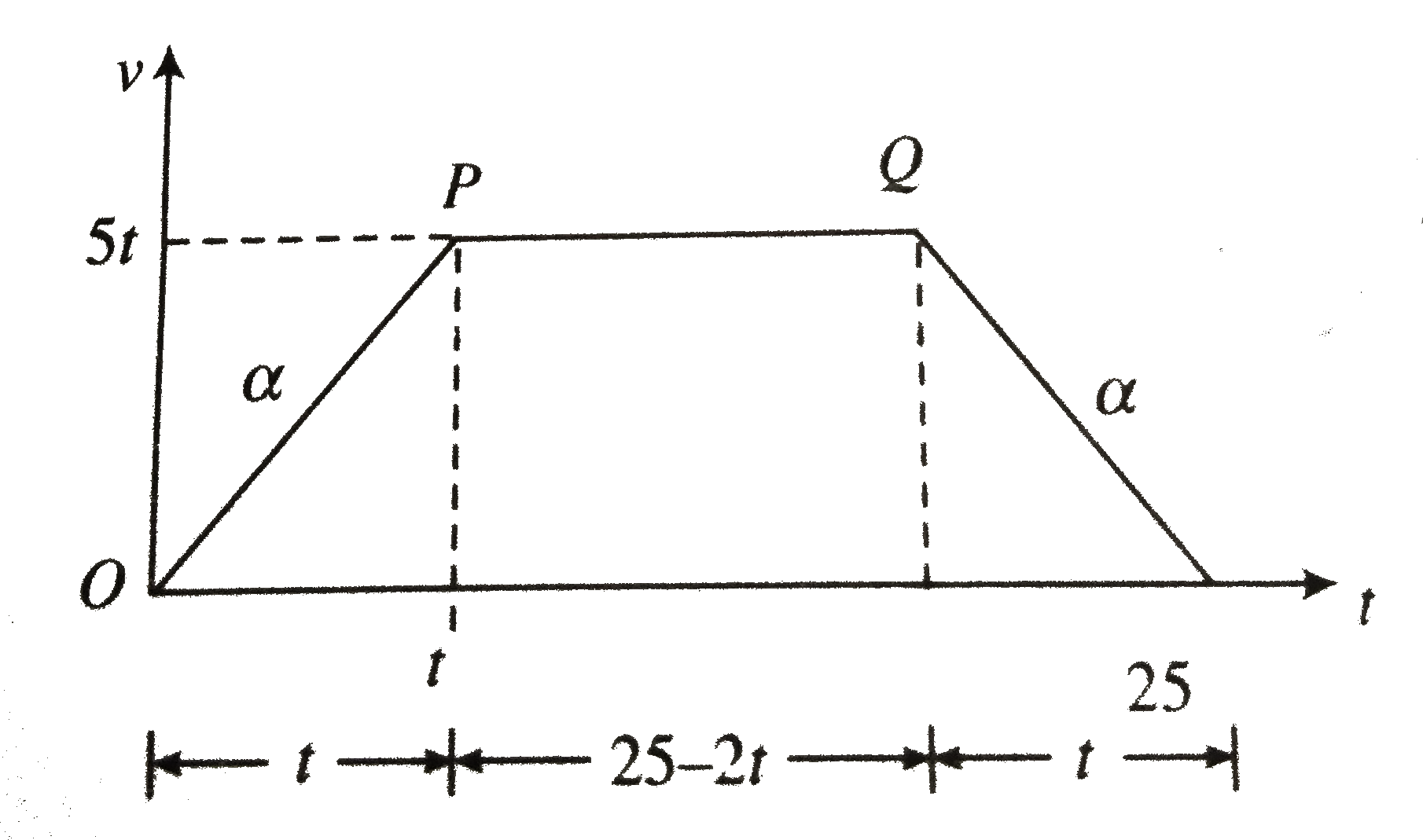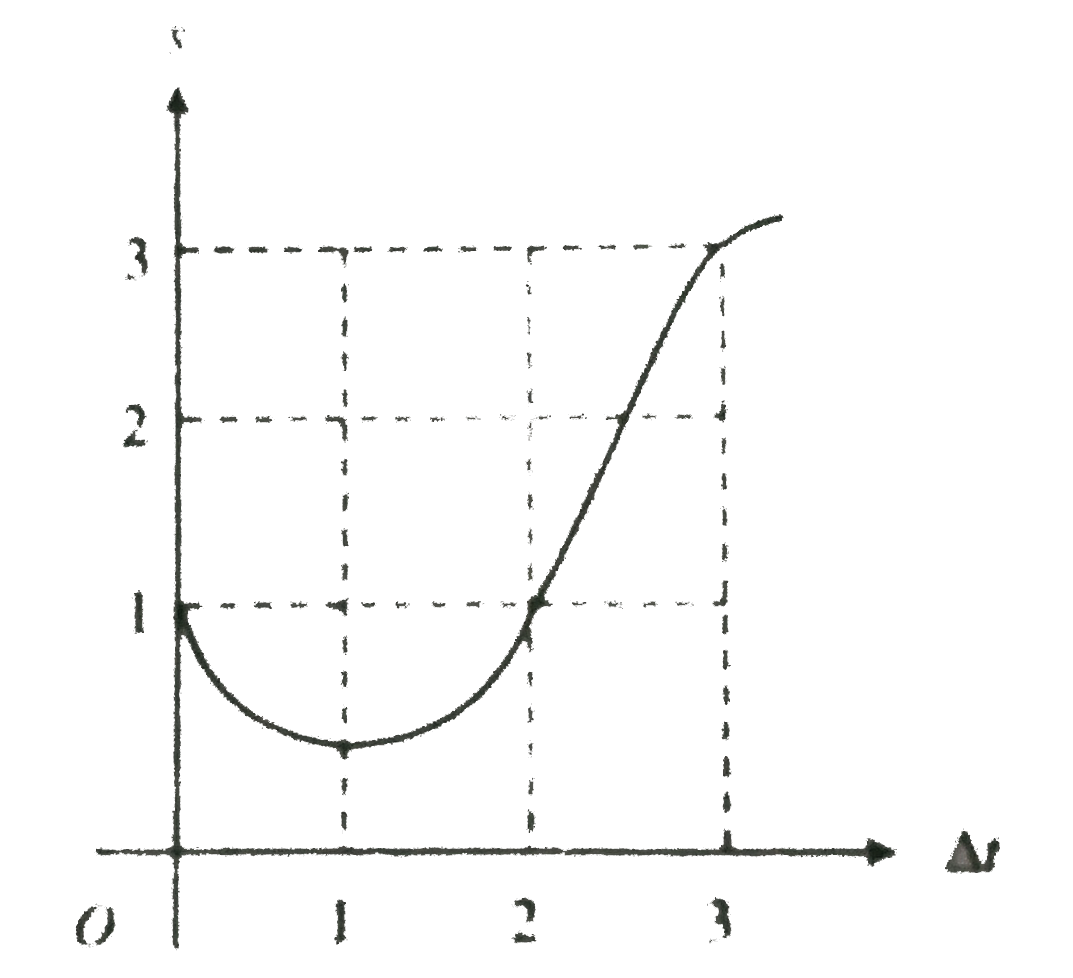A car starts moving rectilinearly first with acceleration α=5ms−2 (the initial velocity is equal to zero), then uniformly, and finally, deceleration at the same rate α comea to a stop. The time of motion equals t=25s. The average velocity during this time is equal to <br>=72 km h^(-1) How long does the car move unitromly?
Let t be the time up to which the car accelerates or decelerates. The maximum velocity attained in this duration is 5t, The time upto which car moves uniformly=25−2t. The velocity-tme graph of the motion of car is drawn as shown as shown in
 .
.
Given the average velocity is whole time of motion
vav=72×518=20ms−1
The average velocity from the graph can obtained as
vav=TotaldisplacementTotaltime
20=(12×[25+(25−2t)]×5t)]×5t)25=((1)/(2)xx[50-2t)]xx5t)/(25)<br>200=50 t-2t^(2)<br>rArr t^(2)-25t+100=0<br>rArr (t-20) (t-5) =0 rArrt=5 sor20 s<br>Butt=20 sis¬possib≤.<br>Hence,t=5 s<br>Thetimeup→whichcarmovesuniformly<br>=25-2t=25- 2xx5=15 s.
Topper's Solved these Questions
- KINEMATICS-1BOOK - CENGAGE PHYSICS ENGLISHCHAPTER - KINEMATICS-1EXERCISE - Solved Examples
9 Videos
- KINEMATICS-1BOOK - CENGAGE PHYSICS ENGLISHCHAPTER - KINEMATICS-1EXERCISE - Exercise 4.1
17 Videos
- GRAVITATIONBOOK - CENGAGE PHYSICS ENGLISHCHAPTER - GRAVITATIONEXERCISE - INTEGER_TYPE
1 Videos
- KINEMATICS-2BOOK - CENGAGE PHYSICS ENGLISHCHAPTER - KINEMATICS-2EXERCISE - Exercise Integer
9 Videos
Similar Questions
A car starts moving along a line, first with acceleration a=5 ms−2 starting from rest then uniformly and finally decelerating at the same rate a, comes to rest.The total time of motion is τ=25s. The average velocity during the time is equal to lt v gt =72 km/hr.How long does the partial move uniformly ?
View SolutionA car starts moving along a line, first with acceleration a=5m/s2 starting from rest then uniformly and finally decelerating at the same rate till it comes to rest. The total time of motion is 25s. The average speed during the time is 20m/s. The particle moves uniformly for (2.5x) second. Find the value of x.
View Solution
Knowledge Check
A car starts from rest, attain a velocity of 36kmh−1 with an acceleration of 0.2ms−2, travels 9 km with this uniform velocity and then comes to halt with a uniform deaceleration of 0.1 ms−2. The total time of travel of the car is
A1050 sB1000 sC950 sD900 s
A ball starts moving in a circular slot with angular acceleration α=2rad/s2 at t=0 The angle between its velocity and acceleration varies with time as
View SolutionA body starts from rest and travels a distance S with unitorm acceleration, then moves uniformly a distance 2S uniformly , and finally cones to rest after moving further 5S under uniform retardation. The ratio of the average velocity to maximum velocity is.
View SolutionThe velocity-time graph of a particle moving along a straight line is shown is . The rate of acceleration and deceleration is constant and it is equal to 5ms−2. If the a average velocity during the motion is 20ms−1, Then
 .
.
The value of t is.
View SolutionA car initially at rest starts moving with a constant acceleration of 0.5 m s−2 and travels a distance of 25 m. Find : (i) its final velocity and (ii) the time taken.
View SolutionA cockroach moves rectilinearly such that after sometime t0 let its (instantaneous) velocity be equal to its average velocity over that time. Referring to the SΔt graph as shown in , for the motion of the cockroach, find the time t0 and the average velocity of the cockroach over the time t0
 .
.
View SolutionA car moves in a straight line, the car accelerates from rest with a constant acceleraation α on a straight foad. After gaining a velocity v, the car moves with that velocity for somerime. Then car decelerates with a retardation β, If the total distance covered by the car is equal to s find the total time of its motion.
View SolutionThe velocity-time graph of a particle moving along a straight line is shown is Fing. The rate of acceleration and deceleration is constant and it is equal to 5ms−2. If the a average velocity during the motion is 20ms−1, Then
 .
.
The distace travelled with uniform velcoty is .
View Solution
